Dinosaurs
This page is filled with pictures of artifacts, cave paintings, and other concrete evidence along with many ideas and explanations that oppose what you will likely see in movies and books about the time in which dinosaurs walked the Earth. Rather than blindly accepting that dinosaurs did exist millions of years ago, and thus the Bible is untrustworthy, I strove to be objective and find evidence that suggests that the assigned age we give to dinosaurs is incorrect. Through my research, I have accomplished what I strove to do. Of course all the evidence given here supports the idea that dinosaurs went extinct relatively recently, but other than dates given by faulty dating methods, I have found no evidence anywhere supporting the alternate view. I have included a reference to which pages I got which pictures from at the bottom of the page.
Dinosaurs in the Bible
The veracity of the events described in the Bible will always be subject to scrutiny due to the sometimes supernatural nature of its stories. However, some passages should be accepted as true simply because they are told as passing comments or descriptive phrases. In other words, we have no reason to doubt the truth of some passages simply because they don't address any beliefs of the Christian faith, and therefore were almost undoubtedly unbiased. One such passage is the description of the "behemoth" in Job 40. The passage reads as follows:
| "'Look at the behemoth, which i made along with you and which feeds on grass like an ox. What strength he has in his loins, what power in the muscles of his belly! His tail sways like a cedar; the sinews of his thighs are close-knit. His bones are tubes of bronze, his limbs like rods of iron. He ranks first among the works of God, yet his Maker can approach him with his sword. The hills bring him their produce, and all the wild animals play nearby. Under the lotus plants he lies, hidden among the reeds in the marsh. The lotuses conceal him in their shadow; the poplars by the stream surround him. When the river rages, he is not alarmed; he is secure, though the Jordan should surge against his mouth. Can anyone capture him by the eyes, or trap him and pierce his nose?'" |
| _____________________________________________________-Job 40:15-24 (NIV) |
No one is certain what the behemoth actually is. Some people claim that it is probably one of several animals that we are familiar with today, such as the elephant, hippopotamus, or even rhinocerous. However, this description does sound quite similar to the description we have today of plant eating dinosaurs, such as the Brontosaurus or Brachiosaurus. Further, the elephant, hippopotamus, and rhinocerous all are in the same general size range and all look similar (to a degree) to one another. The fact that this passage says "He ranks first among the works of God..." implies that the organism being described is dominant and more fascinating than any other animal by a wide margin. A dinosaur looks nothing like any of those types of animals.
Many skeptics deny that this passage refers to a dinosaur by saying that if there were dinosaurs when The Bible was written, much more would have been written about them than just a chapter in Job. However, first, consider the fact that if dinosars did exist with humans, they most likely would not have lived in very close proximity, so to see a dinosaur would probably not be an everyday occurence. Also, compare the mentioning of the dinosaur in Job with other animals that we know existed in Biblical times, and you'll find that one reference is plenty. Other than the behemoth passage, the elephant, rhinocerous, and hippopotamus are not mentioned. Other obscure animals who we readily admit went with Noah on the Ark, such as the zebra and giraffe were never mentioned, and the antelope is only mentioned twice. Even the wolf, used much more as a symbol than an actual part of a story, is only used in 5 passages of The Bible. Therefore, to be mentioned one time in The Bible should be evidence enough that it existed. (verify these facts with Bible Gateway.)
Dinosaurs in Literature and Culture
Most people believe that dragons are a complete myth, a product of fairy tales from the overactive minds of their authors. However, when examined more carefully, you can find that dragons really did exist, or at least were based on creatures that did actually exist. (I would like to clarify for future reference, I am not referring to the komodo dragon, a species of reptile that exists today. I am referring to the much larger and more powerful dragon of classic literature, possibly a type of dinosaur.) Take for example the poem "Beowulf". In the end of the story, the king and hero Beowulf slays dragon that has been ravaging his kingdom for years. This piece of literature also expresses very strongly held Christian beliefs. How likely is it that the author, a devout Christian, while in some areas expressing a deep devotion to God, would intentionally lie and mislead the readers to believe dragons existed, when in reality he knew that they really didn't exist. The answer is obvious. Many other early poems and stories deal with dragons in the same way, and every time the description of the dragon strongly resembles the description of a dinosaur.
Perhaps the best proof that large powerful dragons, or in other words dinosaurs, existed is through the Chinese Calendar. The Chinese Calendar, established in 2600BC assigns one animal to each year in a 12 year cycle. Those animals are the rat, ox, tiger, rabbit, dragon, snake, horse, sheep, monkey, rooster, dog, and boar. As you can see, all the animals except the dragon are well known and in existance today. Again, how likely is it that when deciding what animals to assign to each year, Buddha figured it would be fine to add one mythological creature that doesn't exist to the other 11 creatures that do exist. That simply does not make sense. Obviously, dragons are based on fact.
| Here's a couple examples of how the Chinese represent the dragon in their Calendar. This makes it clear that they are not referring to Komodo Dragons, but they are in fact referring to "mythological" dragons. |   |
Dinosaurs in Art
If dinosaurs did exist at the same times humans existed, it is extremely probable that some pictoral record of them would have been kept by the witnesses on cave walls or pottery. In fact, there is such artwork, and many pictures have been documented. These are some of the best examples I have found:
| Picture | Description |
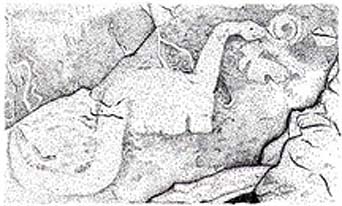 | Found in Utah. Attributed to the Anasazi Indians, who inhabited the area from AD 400 to AD 1300. [1] |
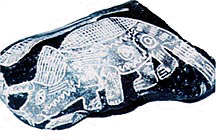 [1] [1]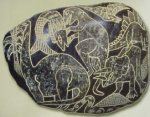 [2] [2]
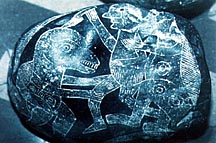 [1] [1] | Indians in Peru most likely made these burial stones 2000 years ago. [1] |
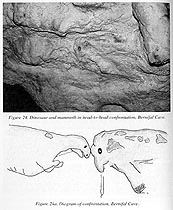 | A rock carving from Bernifal Cave in France. Depicts a dinosaur fighting some kind of animal. [1] |
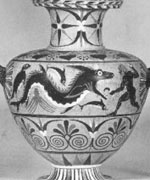 | Found in Turkey, dated to approximately 530 BC. Depicts what might be a Mosasaurus swimming with known sea creatures [2] |
 | The picture on the left is from a Mesopotamian cylinder seal from Egypt in about 3300 BC. The picture on the right is a modern day conception of an Apatasaurus. Strikingly similar. [2] |
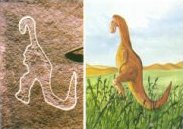 | The picture on the left was found in Havasupai Canyon in Arizona. (The concentrated white outline has been added, the original carving is visible within the darker white outlines.) The picture on the right is the Edmontosaurus. [2] |
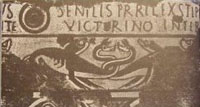 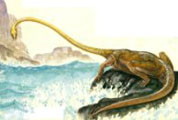 | The left picture is a Roman mosaic dated at 200 AD. The picture on the right is a Tanystropheus. Another very strong similarity. [2] |
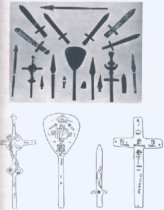  | This Roman sword has what is without a doubt a dinosaur carved on the blade. [2] |
 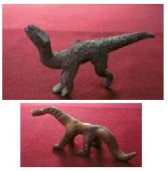 | These clay figures were found in Acambaro, Mexico and have been dated between 800 and 200 BC. Attempts to disprove the authenticity of these figures have failed. [2] |
 | This artwork is by an ancient group of people called the Sumatrans. The creatures on this artwork look like Hadrosaurs. [2] |
 | This is a French wood carving dating back to the 16th century. It looks very similar to the pterosaur. [2] |
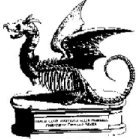 | This is a picture of a dragon that ravaged Rome in the 17th century. This is compared to the Scaphognathus. [2] |
 | This is a different type of evidence than all my other pictures. This is a picture of a fossilized hammer that was dated to be 140 million years old. There are three choices for how this can be: either dinosaurs made tools, humans and dinosaurs lived at the same time 140 million years ago (which shoots evolution down), or modern dating methods are highly innacurate. In fact, the second two choices are probably true. [3] |
Fossil Problem
Unfossilized red blood cells and hemoglobin have been found in some dinosaur bones. Since they are almost entirely made of water, they can only conceivably last a few thousand years without deteriorating. The 65 million years required by evolutionists is out of the question. [5]
Mokele Mbembe
Perhaps dinosaurs have not even comletely become extinct yet. Perhaps in the remotest parts of the world, some dinosaurs have survived the development of cities and society. Deep in

Mokele Mbembe drawing compared to a native | the African Congo exists a swampy area largely unexplored by humans. The government has declared this area, roughly the size of Florida, to be 80% unexplored by man. If dinosaurs exist anywhere, this is a good place to start looking. It comes as no surprise, then, to learn that for nearly 200 years there have been reports of massive, elephant-like creatures who inhabit the swamp. It is called the mokele mbembe by the natives, and is described by natives to have a long neck, long tail, and large tracks with three claws. It is somewhere from 16 to 32 feet long and spends most of its time under water. There have been several expeditions to try to confirm the existence of this creature, but all attempts have failed. This may seem to weaken the case for its existence, but when you factor in the dangerous area, the hostile natives, and the fact that a civil war is taking place there right now, it is easy to understand why no expedition has brought back photos of the animal. However, many of the men who go on the expeditions--some of whom are evolutionists--do come back with reports of either the creature, or its tracks. Perhaps the best supporting argument for the existence of the Mokele Mbembe is the natives' descriptions of it. When a modern drawing of a sauropod was shown to these natives, who have no idea when dinosaurs "lived" or even what a dinosaur is, the natives identified the sauropod as the animal they had seen. Even more interesting is that the descriptions of appearance and habits of the animal are highly similar among different tribes, despite the lack of communication that exists between the tribes. Altogether, this builds quite a strong case for the existence of the Mokele Mbembe. Explorations are currently being done in the Congo, so if any new information appears, I will post it here. [6] |
Dinosaurs: An Overview
Without even considering the very great amount of problems involved with carbon and radiometric dating, (which are discussed here) we have provided extremely strong evidence that dinosaurs definitely existed in the same time frame as humans, and possibly even exist today. This completely blows the Old Earth Theory to shreds and gives strong support for the Young Earth Theory. Despite what you may have been taught all your life, if all the evidence suggesting a Young Earth is placed on a scale against all the evidence suggesting an Old Earth, Young Earth far outweighs. We now have established that tangible evidence that suggests that dinosaurs have recently existed does in fact exist. If nothing else, I hope all this information has at least made you question the time in which dinosaurs existed, to an extent that you will continue your search for the truth elsewhere. The pages listed below are the sites I got the pictures and descriptions from. Please visit these pages as well as the pages in the links section.
References
[1]: Project Creation.
[2]: Genesis Park.
[3]: The Interactive Bible.
[4]: Christian Answers.
[5]: Answers in Genesis.
[6]: True Authority.
Main Page.



 [1]
[1] [2]
[2] [1]
[1]












